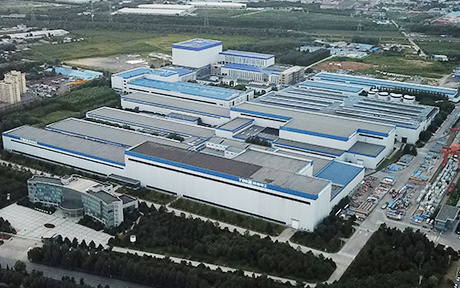
High-rise steel structure
Keyword:
steel structure
structural steel
Category:
Detail
1. Definition of high-rise steel structure
High-rise steel structure generally refers to a structural system with more than six layers (or more than 30m), mainly using section steel, steel plate connection or welding into components, and then connecting and welding. It is composed of steel columns, steel beams, support systems and other mail connected through nodes. Due to the high strength, small cross-section, and large length of steel components, it is necessary to check the strength and stability of the structure.
The main structural system of high-rise steel structure building in China is pure frame structure, frame-support structure, frame-concrete shear wall (core tube) structure, steel cylinder structure, giant frame structure, etc. as the main structural form, and the main structural system of high-rise steel structure is distinguished by the form of anti-lateral force members, the material of the component, the force performance of the component and other factors.
2. Requirements for high-rise steel structure material selection
(1) The principle of steel selection
The principle of steel selection is: not only can make the structure safe and reliable and meet the requirements of use, but also to save steel and reduce the cost to the greatest extent possible. Different conditions of use should have different quality requirements. Of course, high-quality steel should not be easily selected in the general structure, and poor quality steel cannot be blindly selected in the main structure. As far as the mechanical properties of steel are concerned, yield point, tensile strength, elongation, cold bending performance, impact toughness and other indicators are indicators to measure the amount of steel material from various aspects, and when designing the steel structure, the appropriate steel should be selected according to the characteristics of the structure. Whether the steel selection is suitable is not only an economic issue, but also related to the safety and service life of the structure.
The following structural features should be considered when selecting steel:
1. The type and importance of the structure
Due to the different conditions of use, the part of the structure and other aspects, the structure can be divided into three categories: important, general and secondary. For example, civil long-span roof trusses, heavy-duty working crane girders, etc. are important; The roof trusses and columns of ordinary factory buildings belong to the general; Ladders, railings, platforms, etc. are secondary, and steel grades should be selected differently according to different situations.
2. The nature of the load
According to the nature of the load to be undertaken, the structure can be divided into two types: bearing static load and bearing dynamic load. In structures or components subjected to dynamic loads, there is a distinction between often full load and infrequent full load. Therefore, different grades should be used for different load properties. For example, for heavy-duty crane girders, steel with good impact toughness and fatigue properties should be selected, such as Q345C or Q235C. For structures or components that are generally subjected to static loads, such as ordinary welded roof trusses and columns (under normal temperature conditions), Q235BF can be used.
3. Connection method
Different joining methods have different requirements for steel quality. For example, welded steel, due to the inevitable welding stress, welding deformation and welding defects in the welding process, in the case of change of force properties and temperature changes, it is easy to cause notch sensitivity, resulting in cracks in the components, and even brittle fracture, so the welded steel structure has high requirements for the chemical composition, mechanical properties and weldability of steel. For example, the content of carbon, sulfur and phosphorus in steel should be low, the plasticity and toughness indicators should be high, and the weldability should be good. However, for non-welded structures, such as those connected by high-strength bolts, these requirements can be relaxed.
(2) Basic requirements for the selection of high-rise steel structure materials
1. The steel type, steel number, strength design value, selection principle and mechanical properties, chemical composition limits, etc. of the steel used in the high-rise steel structure, as well as the welding materials, bolt fasteners and other materials used in the connection, in addition to the cold bending performance of the steel as the basic guarantee condition, other is basically the same as the general steel structure, and the strength design value of the thick plate steel should be implemented in accordance with the provisions of the "High-rise Building Steel Structure Design and Construction Regulations". In addition, Q235A grade ordinary carbon structural steel is only suitable for secondary non-welded components.
2. The steel performance of the steel structure of earthquake-resistant high-rise buildings should also meet the following requirements:
(1) The yield ratio of steel is not less than 1.2, and the structure of seismic fortification above 8 degrees is not less than 1.5;
(2) There are obvious yield steps, the elongation is greater than 20%, and there is good weldability to maintain ductility;
(3) The steel yield point of the steel structure of Class A and B high-rise buildings should not exceed 10% of its standard value.
3. When the load-bearing structure is exposed and low temperature environment, its steel should also consider the requirements of atmospheric corrosion resistance and avoiding low temperature and cold brittleness.
4. Within the range of beam-column nodes with welded connections, when the node constraint is strong, the plate thickness is greater than 50mm, and the tensile force along the plate thickness direction is beared, the elongation guarantee in the plate thickness direction (greater than 20%~25%) should be added to prevent layered tearing.
5. In the same high-rise structure, different steel grades and strength levels can be selected according to the parts and forces of the components.
6. The profiled steel plate used in the enclosure structure and composite plate should use Q235 steel.
7. The shear bolt welding nails used in the high-rise steel structure, the nail rod magnetic ring and other materials should meet the requirements of the relevant standards, and the welding should use special welding machine welding tools to ensure its shear bearing capacity.
8. The concrete labels, steel bars and design strength used in the composite floor slabs and composite components of the steel structure of high-rise buildings, as well as light aggregate concrete materials, should meet the requirements of the current national regulations.
inquiry
Contact us
Factory address: Jiefang Village, Guanghui Street, Yuhong District, Shenyang City

Official account

Mobile website







